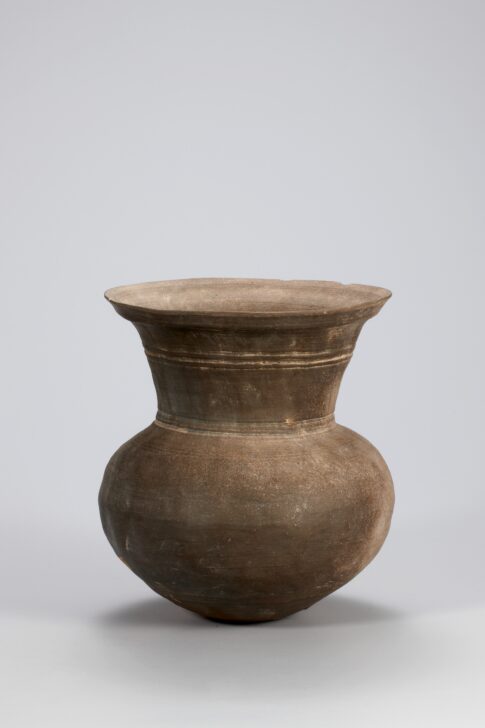Round-Bottomed Jar with Wide Flared Mouth
Korean

Description
March 28, 2009
Clay requires firing temperatures of 1000 degrees Celsius or more to vitrify into stoneware. In Korea, this high firing temperature for unglazed stoneware was made possible by the introduction from China of a wood-fueled climbing kiln. This tunnel-like structure built into a hillside provided a good updraft for the production of an intense and steady fire. The enclosed kiln also restricted the oxygen that flowed into the firing chamber (called a reduction atmosphere), resulting in the characteristic gray tone of Three Kingdoms–period pots. Spherical jars like this with elongated necks and wide flaring mouths are typically found in Gaya tomb sites in southeastern Korea.
(Label for UMMA Korean Gallery Opening Rotation, March 2009)
Subject Matter:
Storage jar.
Archaeological evidence indicates that this ceramic type was first developed in the Kaya region, and subsequently adopted in Silla. While earlier coil-built pottery was uneven and restricted in form, the Kaya-Silla wares were thrown on a fast wheel giving them thin, and even walls. They were fired at high temperature (about 800°C), in efficient, large single-chambered kilns, which made them tough and non-porous.
Physical Description:
Spherical stoneware jar with an elongated neck and wide flaring mouth. Two indented bands stretch across the base of the neck and repeat halfway up the neck as it flares outward.
This is a dark grayish brown, long-necked, high-fired stoneware jar with a wide mouth. Its neck splays diagonally upwards before spreading horizontally just below the mouth and flaring out upwards once again. Two wide, shallow lines forming a raised band mark the boundary where the neck and body meet. A similar type of raised band surrounds the upper-middle part of the neck. The body is widest at its middle part. Its outer surface shows faint traces of having been rendered with a paddled pattern, as well as water smoothing marks in a lateral direction. The base is round and contains clear traces of rotation and water smoothing. The inner surface of the neck shows irregular and rough traces of the supporting anvil (used during the paddling process) in a vertical direction, as well as rotation and water smoothing marks.
[Korean Collection, University of Michigan Museum of Art (2017) p. 49]
Usage Rights:
If you are interested in using an image for a publication, please visit https://umma.umich.edu/request-image/ for more information and to fill out the online Image Rights and Reproductions Request Form.